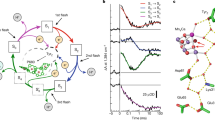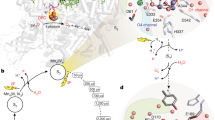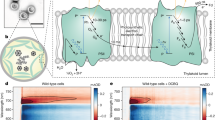Abstract
The oxygen that we breathe is produced by photosystem II of cyanobacteria and plants. The catalytic centre, a Mn4Ca cluster, accumulates four oxidizing equivalents before oxygen is formed, seemingly in a single reaction step1,2,3,4,5,6,7,8 2H2O⇌O2 + 4H+ + 4e-. The energy and cycling of this reaction derives solely from light. No intermediate oxidation product of water has been detected so far. Here, we shifted the equilibrium of the terminal reaction backward by increasing the oxygen pressure and monitoring (by absorption transients in the near-ultraviolet spectrum) the electron transfer from bound water into the catalytic centre. A tenfold increase of ambient oxygen pressure (2.3 bar) half-suppressed the full progression to oxygen. The remaining electron transfer at saturating pressure (30 bar) was compatible with the formation of a stabilized intermediate. The abstraction of four electrons from water was probably split into at least two electron transfers: mildly endergonic from the centre's highest oxidation state to an intermediate, and exergonic from the intermediate to oxygen. There is little leeway for photosynthetic organisms to push the atmospheric oxygen concentration much above the present level.
This is a preview of subscription content, access via your institution
Access options
Subscribe to this journal
Receive 51 print issues and online access
$199.00 per year
only $3.90 per issue
Buy this article
- Purchase on Springer Link
- Instant access to full article PDF
Prices may be subject to local taxes which are calculated during checkout




Similar content being viewed by others
References
Barber, J. Photosystem II: the engine of life. Q. Rev. Biophys. 36, 71–89 (2003)
Renger, G. Photosynthetic water oxidation to molecular oxygen: apparatus and mechanism. Biochim. Biophys. Acta 1503, 210–228 (2001)
Robblee, J. H., Cinco, R. M. & Yachandra, V. K. X-ray spectroscopy-based structure of the Mn cluster and mechanism of photosynthetic oxygen evolution. Biochim. Biophys. Acta 1503, 7–23 (2001)
Zouni, A. et al. Crystal structure of photosystem II from Synechococcus elongatus at 3.8 Å resolution. Nature 409, 739–743 (2001)
Kamiya, N. & Shen, J. R. Crystal structure of oxygen-evolving photosystem II from Thermosynechococcus vulcanus at 3.7-angstrom resolution. Proc. Natl Acad. Sci USA 100, 98–103 (2003)
Ferreira, K. N., Iverson, T. M., Maghlaoui, K., Barber, J. & Iwata, S. Architecture of the photosynthetic oxygen-evolving center. Science 303, 1831–1838 (2004)
Rutherford, A. W. Photosystem II, the water-splitting enzyme. Trends Biochem. Sci. 14, 227–232 (1989)
Kok, B., Forbush, B. & McGloin, M. Cooperation of charges in photosynthetic O2 evolution - I. A linear four-step mechanism. Photochem. Photobiol. 11, 457–475 (1970)
Hendry, G. & Wydrzynski, T. O-18 isotope exchange measurements reveal that calcium is involved in the binding of one substrate-water molecule to the oxygen-evolving complex in photosystem II. Biochemistry 42, 6209–6217 (2003)
Hillier, W., Messinger, J. & Wydrzynski, T. Kinetic determination of the fast exchanging substrate water molecule in the S3 state of photosystem II. Biochemistry 37, 16908–16914 (1998)
Renger, G. in Photosynthetic Oxygen Evolution (ed. Metzner, H.) 229–248 (Academic, London, 1978)
Clausen, J., Debus, R. J. & Junge, W. Time-resolved oxygen production by PSII: Chasing chemical intermediates. Biochim. Biophys. Acta 1655, 184–194 (2004)
Babcock, G. T., Blankenship, R. E. & Sauer, K. Reaction kinetics for positive charge accumulation on the water side of chloroplast photosystem II. FEBS Lett. 61, 286–289 (1976)
Dekker, J. P., Plijter, J. J., Ouwehand, L. & van Gorkom, H. J. Kinetics of manganese redox transitions in the oxygen evolving apparatus of photosynthesis. Biochim. Biophys. Acta 767, 176–179 (1984)
Renger, G. & Weiss, W. Studies on the nature of the water oxidizing enzyme. III. Spectral characterization of the intermediary redox states in the water-oxidizing enzyme system Y. Biochim. Biophys. Acta 850, 184–196 (1986)
Saygin, Ö. & Witt, H. T. Optical characterization of intermediates in the water-splitting enzyme system of photosynthesis—possible states and configurations of manganese and water. Biochim. Biophys. Acta 893, 452–469 (1987)
Haumann, M., Bögershausen, O., Cherepanov, D. A., Ahlbrink, R. & Junge, W. Photosynthetic oxygen evolution: H/D isotope effects and the coupling between electron and proton transfer during the redox reactions at the oxidizing side of photosystem II. Photosynth. Res. 51, 193–208 (1997)
Hundelt, M., Hays, A. M., Debus, R. J. & Junge, W. Oxygenic photosystem II: the mutation D1-D61N in Synechocystis sp. PCC 6803 retards S-state transitions without affecting electron transfer from YZ to P680+. Biochemistry 37, 14450–14456 (1998)
Karge, M., Irrgang, K. D. & Renger, G. Analysis of the reaction coordinate of photosynthetic water oxidation by kinetic measurements of 355 nm absorption changes at different temperatures in photosystem II preparations suspended in either H2O or D2O. Biochemistry 36, 8904–8913 (1997)
Rappaport, F., Blanchard-Desce, M. & Lavergne, J. Kinetics of electron transfer and electrochromic change during the redox transition of the photosynthetic oxygen-evolving complex. Biochim. Biophys. Acta 1184, 178–192 (1994)
Clausen, J. et al. Photosynthetic water oxidation: Mutations of D1-Glu189K, R and Q of Synechocystis sp. PCC6803 are without any influence on electron transfer rates at the donor side of photosystem II. Biochim. Biophys. Acta 1506, 224–235 (2001)
Lavergne, J. Improved UV-visible spectra of the S-transitions in the photosynthetic oxygen-evolving system. Biochim. Biophys. Acta 1060, 175–188 (1991)
Dekker, J. P. in Manganese Redox Enzymes (ed. Pecoraro, V. L.) 85–104 (VCH Publishers, New York, 1992)
Haumann, M., Drevenstedt, W., Hundelt, M. & Junge, W. Photosystem II of green plants: Oxidation and deprotonation of the same component (histidine?) on S1* → S2* in chloride depleted centers as on S2 → S3 in controls. Biochim. Biophys. Acta 1273, 237–250 (1996)
Rappaport, F. & Lavergne, J. Coupling of electron and proton transfer in the photosynthetic water oxidase. Biochim. Biophys. Acta 1503, 246–259 (2001)
Jahns, P., Lavergne, J., Rappaport, F. & Junge, W. Stoichiometry of proton release during photosynthetic water oxidation: a reinterpretation of the response of Neutral red leads to a non-integer pattern. Biochim. Biophys. Acta 1057, 313–319 (1991)
Lavergne, J. & Junge, W. Proton release during the redox cycle of the water oxidase. Photosynth. Res. 38, 279–296 (1993)
Junge, W., Haumann, M., Ahlbrink, R., Mulkidjanian, A. & Clausen, J. Electrostatics and proton transfer in photosynthetic water oxidation. Phil. Trans. R. Soc. Lond. B 357, 1407–1417 (2002)
Beck, W. F., de Paula, J. C. & Brudvig, G. W. Active and resting state of the O2-evolving complex of Photosystem II. Biochemistry 24, 3035–3043 (1985)
Klimov, V. V., Allakhverdiev, S. I., Demeter, S. & Krasnovsky, A. A. Photoreduction of pheophytin in the photosystem II of chloroplasts with respect to the redox potential of the medium. Dokl. Akad. Nauk SSSR 249, 227–230 (1979)
Acknowledgements
We thank H. Kenneweg for technical assistance, H. Heine for advice on the construction of the pressure cell, R. Debus for cooperation on Synechocystis, and R. Ahlbrink and A. Mulkidjanian for discussions and help. This work was financially supported by the Deutsche Forschungsgemeinschaft, the Fonds der Chemischen Industrie and the Land Niedersachsen.
Author information
Authors and Affiliations
Corresponding author
Ethics declarations
Competing interests
The authors declare that they have no competing financial interests.
Supplementary information
Rights and permissions
About this article
Cite this article
Clausen, J., Junge, W. Detection of an intermediate of photosynthetic water oxidation. Nature 430, 480–483 (2004). https://doi.org/10.1038/nature02676
Received:
Accepted:
Issue Date:
DOI: https://doi.org/10.1038/nature02676
This article is cited by
-
Bimetallic cooperation across the periodic table
Nature Reviews Chemistry (2020)
-
Evolution of photosystem I and the control of global enthalpy in an oxidizing world
Photosynthesis Research (2013)
-
Ecophysiology of photosynthesis in macroalgae
Photosynthesis Research (2012)
-
Photosynthetic water oxidation vs. mitochondrial oxygen reduction: distinct mechanistic parallels
Journal of Bioenergetics and Biomembranes (2011)
-
The photosystem II-associated Cah3 in Chlamydomonas enhances the O2 evolution rate by proton removal
The EMBO Journal (2008)
Comments
By submitting a comment you agree to abide by our Terms and Community Guidelines. If you find something abusive or that does not comply with our terms or guidelines please flag it as inappropriate.



